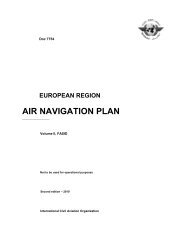7754 Vol 1 Flyleaf - ICAO Public Maps
7754 Vol 1 Flyleaf - ICAO Public Maps
7754 Vol 1 Flyleaf - ICAO Public Maps
You also want an ePaper? Increase the reach of your titles
YUMPU automatically turns print PDFs into web optimized ePapers that Google loves.
Part IV<br />
COMMUNICATIONS, NAVIGATION<br />
AND SURVEILLANCE (CNS)<br />
GENERAL<br />
1. Communications, Navigation and Surveillance (CNS)<br />
facilities and services should meet the requirements of those<br />
other components of the air navigation system which they are<br />
intended to serve.<br />
2. In planning for those other components, economy and<br />
efficiency should be taken into account in order to ensure<br />
that the requirements for the provision of CNS facilities and<br />
services can be kept to a minimum.<br />
3. CNS facilities and services should fulfil multiple<br />
functions whenever this is feasible.<br />
COMMUNICATIONS<br />
AERONAUTICAL FIXED SERVICE (AFS)<br />
Basic requirements<br />
4. The aeronautical fixed service (AFS) should satisfy the<br />
communication requirements of ATS, ATFM, AIS, MET<br />
and SAR, including specific requirements in terms of system<br />
reliability, message integrity and transit times, with respect<br />
to printed as well as digital data and speech communications.<br />
If need be, it should, following agreement between<br />
individual States and aircraft operators, satisfy the<br />
requirements for airline operational control.<br />
[Annex 3, 11.1; Annex 11, 6.2; Annex 12, 2.4; Annex 15,<br />
Chapter 9; Annex 10, <strong>Vol</strong>ume II, Chapter 4]<br />
5. To meet the data communication requirements, a uniform<br />
high-grade aeronautical network should be provided, based<br />
on the aeronautical telecommunication network (ATN),<br />
taking into account the existence and continuation of current<br />
networks. This network is hereafter referred as the<br />
EUR-ATN Network.<br />
[Annex 10, <strong>Vol</strong>ume III, Part I]<br />
Existing network<br />
IV-1<br />
6. Pending future development of the EUR ATN, the current<br />
requirements should be met by the use of:<br />
a) Aeronautical Fixed Telecommunication Network<br />
(AFTN);<br />
b) Common <strong>ICAO</strong> Data Interchange Network (CIDIN)<br />
and CIDIN COM centres;<br />
c) ATS message handling systems (AMHS), AMHS<br />
COM centres and gateways;<br />
d) dedicated networks of ATS providers;<br />
e) Operational meteorological information (OPMET)<br />
circuits and centres;<br />
f) ATS speech networks and circuits;<br />
g) ATS computer-to-computer data networks and<br />
circuits; and<br />
h) the Satellite distribution system for information<br />
relating to air navigation (SADIS).<br />
7. All possible arrangements should be made to ensure that,<br />
in case of breakdown of a communications centre or circuit,<br />
at least high-priority traffic continues to be handled by<br />
appropriate means.<br />
8. Emergency procedures should be developed to ensure that,<br />
in case of a centre breakdown, all the parties concerned are<br />
promptly informed of the prevailing situation.<br />
9. AFS planning should permit flexibility in detailed<br />
development and implementation.<br />
The EUR-ATN network














